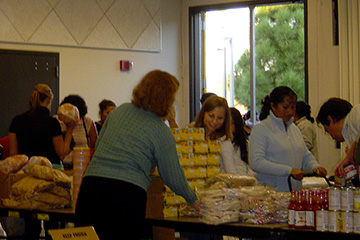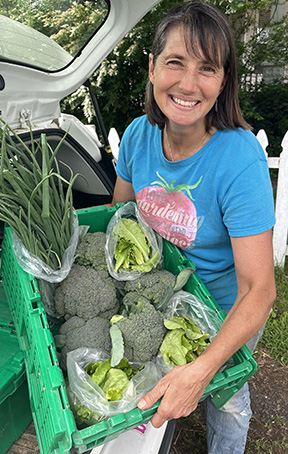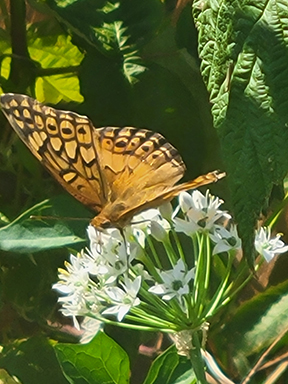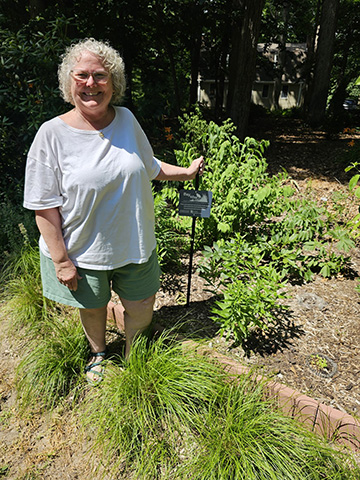The public is invited to attend the July 17 meeting of the Democratic Club of Kent County. Deeann Jones, Program Director of the Kent County Community Food Pantry, and Sandy Zappia, owner of Sandy’s Garden, will discuss the food insecurity in Kent
County and how residents can help alleviate it. Given cuts in food programs like SNAP this is a timely topic. The Food Pantry, located at Chestertown’s First United Methodist Church, provides food that meets the basic nutritional needs of all qualified Kent County clients. Sandy’s Garden, a 3.5-acre farm on Annie Crow Road, works to provide wholesome food to all by growing fresh fruit and vegetables that go to local food pantries.
The Spy Newspapers may periodically employ the assistance of artificial intelligence (AI) to enhance the clarity and accuracy of our content.
Historical Society Receives Preservation Grant from The Questers
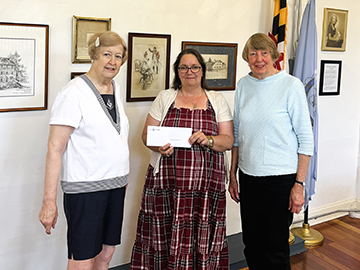
Smiles all around as Courtney Sjostrom and Carol Nelson of the Lambert Wickes Chapter of The Questers present a $1,000 grant to Historical Society Executive Director Maria Wood to help preserve Kent County’s precious history.
With smiles all around, Historical Society of Kent County Executive Director Maria Wood and Board Secretary Erik Gulbrandson recently accepted a $1,000 grant from The Questers, represented by Courtney Sjostrom, Vice President, and Carol Nelson, Past President of the Lambert Wickes Chapter.
The grant will fund the purchase of custom-sized, acid-free archival boxes to safely preserve oversized items in the Society’s collection including family bibles, photo and scrapbook albums, ledgers, and other historically significant items.
“We’re so grateful to the Lambert Wickes Chapter of The Questers for their support,” said Wood. “Last year, we were able to mitigate mold issues affecting some of these historic materials. This grant allows us to take the next critical step, of housing them safely to prevent future damage and ensuring that they can be handled without posing health risks. It’s a meaningful investment in the long-term preservation of Kent County’s history.”
The Maryland Questers organization endorsed the local chapter’s application, recognizing the significant impact these preservation efforts have on safeguarding Kent County’s history for future generations, especially for those researching family heritage.
Founded in 1944, Questers is dedicated to stimulating the appreciation of antiques and encouraging historic preservation. The Lambert Wickes Chapter, one of several in the Chestertown area, has supported the Historical Society over the years to help in the effort to keep the past available to the future. The smiles shared at the check presentation reflect the shared excitement in supporting a key piece of the Society’s larger archival initiative.
The Historical Society offers a welcoming community and invites everyone to consider becoming a member. Membership benefits include unlimited use of the Research Library (by appointment), a discount on books in the museum gift shop, and invitations to members-only events, among others. A donation of $25 is recommended for individual memberships, and $40 for families. Student memberships are always free. Visit www.kentcountyhistory.org for more information, or email [email protected].
The Spy Newspapers may periodically employ the assistance of artificial intelligence (AI) to enhance the clarity and accuracy of our content.
It’s All Food and Sex: Pollinators By Nancy Taylor Robson
Pollination, as most of us know, is about reproduction – of fruits, vegetables other plants. But from our self-interested point of view – and that of most of the animals on terra firma – it’s about food. Apples and pears and squash and watermelon (and so much delicious more!). Pollination is responsible for one of every three bites of food.
“So many of our fruits and vegetable species require pollination before they set fruit,” says Christy Wilhelmi, author of High Yield, Small Space Organic Gardening. “So, we need these guys to survive. If the pollinators die, we die. It’s that simple.”
According to a 2016 study by the Xerces Society for Invertebrate Conservation, pollinators have declined by approximately 75% in the past 27 years. Staggering, but potentially reversible.
As the name suggests, pollination is the transfer of pollen (male) to the female part of a plant. (This is the sex part for those not paying attention). Many plants need more than one visit to a blossom for good pollination. For example, a female zucchini blossom needs about five visits for a single good fruit to develop. Many plants will not produce fruit without pollination from other plants, but even self-pollinated plants benefit from pollinators. A recent University of Vermont study showed that when birds and bees protect coffee plants (and in the course, pollinate them), the result is bigger and more plentiful beans. Bigger, better crop; bigger, better income for growers; more for us grateful caffeinators.
According to the National Park Service, three-quarters of all the flowering plants on earth are pollinated by insects and animals. Of course, we could possibly do it ourselves as China has been forced to do. In Sichuan Province, pesticides and pollution have so decimated the pollinator population there that orchardists must hand-pollinate fruit trees. It’s a painstaking process that needs to be repeated as many as five times per blossom to ensure marketable fruit.
We might do it all ourselves, but why? It’s designed to work efficiently without our intervention. So, if we restore what the pollinators need, it can run on autopilot while we eat caprese salad and grilled chicken with mango salsa.
Pollination is one of the key ecological services provided gratis in an intricately orchestrated regenerative system that also helps stabilize our soils, clean our air, supply oxygen, and support wildlife. Virtually everything in life multitasks.
“The pollinators might be catching prey to provision their nests or feed their larvae, and as adults they are going to flowers to feed themselves, so in that they are transferring pollen around from plant to plant,” says naturalist Nancy Lawson, author of Wildscapes. “And many are decomposers, who are helping to break down wood and other organic matter. Dead animals and other insects who have died would be piling up all around us without these decomposers.”
So, who is a pollinator? We often think primarily of honeybees, who get lots of press – especially since there have been two overturned tractor trailers of them recently.
“Honeybees are not native, but they are such fascinating, self-directed creatures,” says Wilmelmi, who is also a beekeeper. “They run a democracy within their colony, and they are so hardworking.”
Honeybees are interesting to non-beekeepers, too, because in addition to the amazing intricacy of their lives, we realize that the pollination of almonds and other food trees is currently dependent on professional beekeepers hauling thousands of hives around the country in semis. It’s not hand-pollinating, but it is a necessary pollination industry run by human beings. Yet the original arrangement is more complex – and yet so much simpler, less work for us. And cheaper.
A pollinator is anything that helps carry pollen from the male part of the flower to the female part of the same or another flower. Bees of all kinds, (yes, even annoying carpenter bees), butterflies, moths, flies, bugs, beetles, thrips, and wasps. Also, birds and mammals – for example, opossums, who also eat ticks.
“Pollinators come in many forms,” explains Lawson “They’re beetles and flies and wasps, especially. There are so many solitary wasps that people don’t realize are not threatening to us, and they’re all out there pollinating flowers and being natural insect control.”
While we can see the various flying pollinators during the day, the process continues mostly unseen at night.
“Bats not only hoover a thousand mosquitoes out of the sky every night,
but they are nighttime pollinators of cactus, succulents, and tropical fruits like mangos and bananas,” Wilhelmi says.
“Ethiopian wolves pollinate Red Hot Pokers (Kniphofia),” notes Lawson. “They lick the flower, and the pictures of them with pollen all over their faces makes me wonder what other pollinators we just don’t know about [yet].”
So, how can each of us help? Restore habitat for one thing. Just as we need fueling stations and places to sleep on a cross-country road trip, pollinators of all kinds need well-supplied way stations in addition to established communities.
“People already know they should be planting native flowers that native bees and other animals have evolved with,” says Lawson. “They also need to think about massing the same plants, so pollinators pick up on these visual and olfactory signals and cues. If you only have one or two, it won’t have much for many creatures, but start with five near each other and let them spread. And plant really fragrant flowers like native Clematis (Clematis virginiana) and the trees and shrubs – Black Cherry (Prunus serotina), Mountain Mint (Pycnanthemum), Woodland Phlox (Phlox divericota), native roses, Carolina Rose (Rosa carolina) – because scent is really important to bees and other pollinators to help them locate what they need.”
Another key thing is to reduce or eliminate pesticides, (another cost-saving). Then let the good times roll. Once you’ve got a good mix of symbiotically living things, the whole system tends to take care of itself. The result is both productive and fascinating. Discovery channel in your own backyard.
RESOURCES:
https://www.pollinator.org/pollinators
https://www.humanegardener.com/humane-gardening-tenets/
https://www.uvm.edu/gund/news/secret-better-coffee-birds-and-bees
https://www.xerces.org/pollinator-conservation/whats-at-stake
https://extension.umd.edu/resources/#!/category/2/subcategory/68
High Yield, Small Space Organic Gardening by Christy Wilhelmi (Creative Homeowner, 2025
Wildscape: Trilling Chipmunks, Beckoning Blooms, Salty Butterflies, and other Sensory Wonders of Nature by Nancy Lawson (Princeton Architectural Press)
Longtime journalist and essayist Nancy Taylor Robson is also the author of four books: Woman in The Wheelhouse; award-winning Course of the Waterman; A Love Like No Other: Abigail and John Adams, a Modern Love Story; and OK Now What? A Caregiver’s Guide to What Matters, which she wrote with Sue Collins, RN.
The Spy Newspapers may periodically employ the assistance of artificial intelligence (AI) to enhance the clarity and accuracy of our content.
Adkins Arboretum’s Mystery Monday: Guess the Photo!

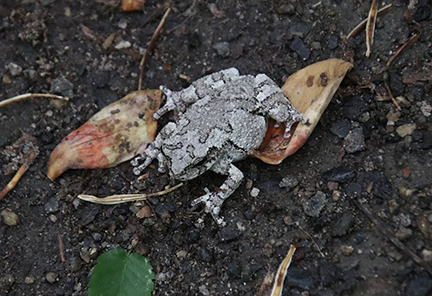
The Spy Newspapers may periodically employ the assistance of artificial intelligence (AI) to enhance the clarity and accuracy of our content.
Rock Hall PorchFest May 25
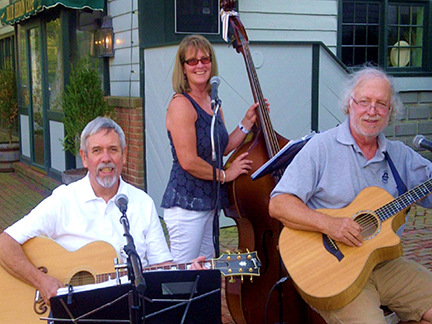
The BFD Band will be one of five acts at Rock Hall PorchFest 2025 on Sunday, May 25 beginning at 12 noon. Admission is free.
Rock Hall’s historic Main Street will come alive with sights and sounds on Sunday, May 25 as the town presents PorchFest 2025.
Five “porch” stages, all within easy walking distance along Main Street, will host consecutive live music shows, starting at 12 noon, and with the last show beginning at 4 p.m.
PorchFest is free to the public, with lots of free parking near Main Street, and visitors will enjoy a leisurely block-long stroll as the festivities travel from one stage to the next. Along the way, there will be time to explore the town’s intriguing shops, and there will be lots to eat and drink from our local merchants. All you really need to enjoy PorchFest are comfortable shoes, a lawn chair perhaps, and an appetite for good music.
The musical lineup:
12 noon – Java Rock (Main and Sharp Sts.), Ashley Chapa, contemporary and classic country;
1 p.m. – Village Quilting (5701 Main St. , John Rutkowski, popular tunes on the accordion;
2 p.m. – The Mainstay (5753 Main St., back bar will be open), The Singing Captains, songs you know and love;
3 p.m. – Rock Hall Village Gazebo (Main St. & Rock Hall Ave.), The BFD Band, Ben Bennington, Ford Schumann, and Deb Campbell with acoustic traditional and contemporary folk;
4 p.m. – The “Brick House” (5778 Main St.), Barbara Parker, local popular and folk chanteuse.
It all adds up to a festive Memorial Day weekend get-together on the friendliest Main Street on the Eastern Shore.
PorchFest is made possible with help from the Kent Cultural Alliance, Main Street Rock Hall, and the visitors and locals who patronize our businesses and support our town. For more information, check out Rock Hall PorchFest on Facebook.
The Spy Newspapers may periodically employ the assistance of artificial intelligence (AI) to enhance the clarity and accuracy of our content.
Celebrating 13 Years of Leadership, Theresa Snyder Retires as KART Executive Director
After 13 years of dedicated leadership, Theresa Snyder, the Executive Director of the Kent Association of Riding Therapy (KART) is retiring.
Under her guidance, the organization has grown in magnitude, reputation, and community impact. With Theresa’s commitment, vision, and guidance, KART expanded from serving just the local public schools, to serving Christian Academy, Camp Fairlee, Kent Center, Horizons, and Heron Point communities.
In addition to handling the day-to-day responsibilities of coordinating volunteers, schools, other organizations, therapy horses, PATH instructors, and additional tasks for the horseback riding therapy sessions at Worthmore, Theresa was also instrumental in finding funding sources for KART, as all of these services for the community with disabilities are provided for free.
Theresa came to KART as a volunteer, and it turns out that she happened to be a grant writer, so fortunate for KART. Theresa has raised over $1,000,000 over the 13 years, writing grants and coordinating fundraising events such as golf tournaments, half marathon/5K runs, River Packet cruises, Kitty Knight House outings, fundraising dinners and more. She was always looking for more ways to fundraise. She played an important role each year, putting together the spring and fall appeal letters and the annual newsletters. Her personal connection with family foundations resulted in more funding for KART.
As Executive Director, she was responsible for KART’s budgets and reporting to the Board of Directors on all activities. Theresa was crucial to a very important KART accreditation: PATH Premier Certification.
PATH is the Professional Association of Therapeutic Horsemanship, Int. and KART is certified as a Premier Accredited Center, thanks to Theresa’s hard work, organizational skills, and attention to detail. The accreditation process is a peer review system in which trained volunteers visit and review centers, in accordance with PATH Intl. standards. A center that meets the strict accreditation requirements based on the administrative, facility, program and applicable activity, and service standards becomes a PATH Intl. Premier Accredited Center for a period of five years. Theresa has done this 3 times for KART. Not an easy task.
Even though Theresa was paid for her ED position, her dedication, commitment, and love for KART was evident when she listed her hours at the barn with the riding sessions as volunteer hours. She had a wonderful way about her relating to the students, volunteers, instructors, board members, and others. She always had a positive attitude and was willing to go above and beyond normal expectations.
Theresa guarantees that she will still be involved with KART, volunteering and serving in an advisory role.
Please join the Board, staff, volunteers, and the community wishing Theresa well and thanking her for all she has done for KART and the community with disabilities. Her passion and foresight will never be forgotten, and her tireless commitment and visionary leadership leave behind a lasting legacy that will guide us for years to come.
Theresa’s successor is a well-qualified horse enthusiast, Daphne Young. We look forward to our next chapters with Daphne, KART’s new ED.
For more information: Daphne Young, Executive Director for KART; [email protected]; 410.870.5536
The Spy Newspapers may periodically employ the assistance of artificial intelligence (AI) to enhance the clarity and accuracy of our content.
Baltimore Restaurateur Unveils Sassafras: An Intimate Modern Chesapeake Dining Experience
Chef Paul Edward, the culinary visionary behind the acclaimed Baltimore restaurant The Bluebird, is embarking on a new venture, bringing his innovative approach to local cuisine to the Eastern Shore with the highly anticipated opening of Sassafras. Perched dramatically atop a cliff in the charming town of Betterton Beach, Sassafras promises a fine dining and intimate supper club experience unlike any other, boasting breathtaking panoramic views of the Chesapeake Bay.
Relocating to the Eastern Shore two years ago with his wife, Caroline Benkert, Chef Edward has meticulously crafted Sassafras as a destination for discerning diners seeking a truly immersive culinary journey. Sassafras will officially open for weekly seatings of just 20 guests starting in June but reservations for the Chef’s Counter Preview Series are now open throughout the month of May.
The heart of Sassafras lies in its prix fixe, 12-course menu, a vibrant celebration of the region’s hyper-seasonal and unique bounty. Edward has coined his culinary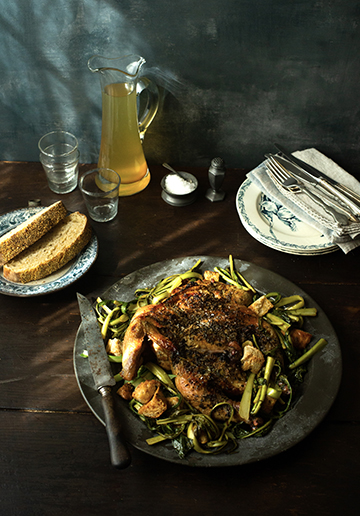 philosophy “Modern Chesapeake Cookery,” emphasizing locally and regionally sourced ingredients, with a strong focus on wild-caught seafood. Guests can anticipate an ever-evolving offering that showcases the freshest catches, such as aged Yellow Fin Tuna, Snakehead, and Catfish, transformed into unforgettable dishes.
philosophy “Modern Chesapeake Cookery,” emphasizing locally and regionally sourced ingredients, with a strong focus on wild-caught seafood. Guests can anticipate an ever-evolving offering that showcases the freshest catches, such as aged Yellow Fin Tuna, Snakehead, and Catfish, transformed into unforgettable dishes.
The one-of-a-kind experience will start with cocktails on the porch overlooking the Bay, and continue in the cozy and thoughtfully curated cabin-esque dining room as Chef Edward charts a culinary journey through all the region has to offer. Local grains and foraged gifts of the meadows and forests, ham of the land and the sea, a unique take on invasive species, as well as bounty from the ocean and regional farms, flesh out the experience. A standout staple is the handcrafted catfish ricotta and farm egg raviolo, generously adorned with Mississippi River sturgeon caviar – the eggs sourced directly from Chef Edward’s own Eastern Shore flock. Other hits from the Preview Series menu have included dry aged Rockfish crudo brightened with a juice of cameo apple and rhubarb, complemented by a textural crumble of toasted black walnuts.
“Sassafras is a culmination of our passion for this region and its incredible ingredients,” says Chef Edward. “We aim to create a dining experience that not only delights the palate but also deeply connects guests to the Chesapeake and the dedication of our local purveyors.”
As Chef Edward establishes Sassafras as a must-visit dining destination, conveniently located a short drive from Baltimore, Washington D.C., and Philadelphia, the Eastern Shore offers a variety of overnight accommodations, encouraging guests to embrace the full experience of an evening at Sassafras.
Poised to become a culinary gem in the region, Sassafras offers a unique and unforgettable dining experience, deeply rooted flavors of the Chesapeake’s waters and shores.
The Spy Newspapers may periodically employ the assistance of artificial intelligence (AI) to enhance the clarity and accuracy of our content.
Memorial Day Event to Feature Parade, Entertainment and a Remembrance of Vets Who Died in Combat
Long after the Tea Party tourists have left town, the Memorial Day parade and remembrance on May 26 – long a locals’ favorite – will honor veterans who died serving their country.
The Memorial Day Committee is inviting members of the community to participate in the parade by creating a float or showcasing vehicles of interest. Walking groups with patriotic themes are also welcome. No pre-registration is required.
Participants will gather at 9 a.m. at Dixon Drive. The parade will start at 10 a.m. and proceed down High Street to Memorial Park. In advance of the parade, from 9-10 a.m., entertainment will be provided by Chester River Voices and the Ukelele Club.
Chestertown River Arts will be on hand to distribute “thank you cards” that will be sent to veterans – or you can make your own. The community arts organization will also be selling tissue paper poppies.
Following the parade, keynote speaker Aubrey Sarvis, an Army veteran, will give a short presentation on the Korean War, which took the lives of over 50,000 Americans.
“It’s often called ‘The Forgotten War’ because most people alive in the U.S. today could not tell you what it is or was,” says Sarvis, a member of Sumner Hall’s board of directors. “It was never even officially declared a war.”
Vanessa Ringgold, Sumner Hall’s president, will talk about Memorial Day’s origins and local veterans will read the names of Kent County service members killed in action in Korea.
To close things out, local veterans will be acknowledged with a moment of silence as trumpeter Brad Holloman plays “Taps.”
The Spy Newspapers may periodically employ the assistance of artificial intelligence (AI) to enhance the clarity and accuracy of our content.
Bay-Wise – It’s All Connected By Nancy Taylor Robson
There was a silver lining to the Charlie Foxtrot that was Covid. People discovered gardening. Even those who had never tried to grow herbs (never mind what kind) in college, flocked to garden centers and bought a plant or 20. ‘Victory gardens!’ the people said. ‘Let us eat vegetables!’
But it was more than a culinary impulse. Gardening – cultivating a plant that silently absorbs our angst and returns beauty, fragrance, butterflies, and maybe even salad – is psychologically nourishing.
It can also positively impact water quality.
“Homeowners are paying a little more attention to how they can adapt practices to help the Bay,” says Rachel Rhodes, Extension Coordinator for Queen Anne’s County, MD.
What we do – or don’t do – on land profoundly affects the health of the Bay, so acting on that knowledge is, as Oprah would say, HUGE.
Bay-Wise, the University of Maryland Extension stewardship program, designed by Senior Agent and Educator Wanda MacLachlan (now retired), offers a straightforward plan.
“I wanted to create a holistic approach to individual land management,” MacLachlan explains.
Key to the program is the Bay-Wise Yardstick, which has 61 possible steps broken into eight categories. Plus, steps taken in one category often spill benefits into others. For example, the native shrubs, trees, ground covers, and grasses you’ve planted to Control Stormwater Runoff and prevent erosion also act as shelter, habitat, and food source, so they Encourage Wildlife. While the Plant Wisely category urges using wind-breaking evergreens on the north and deciduous trees on the south to cut down on energy use, they also provide habitat and draw pollinators and birds (natural Integrated Pest Management) that benefit your victory garden.
Encouraging wildlife also offers enormous entertainment. Seeing a troop of ten cedar waxwings pass a Winterberry fruit (Ilex verticillata) from one bird to the next on a branch or watching a fat baby robin test his barely-fledged wings while his nest-bound siblings shout, “Go on! I dare ya!” at him, is like a homegrown Discovery channel.
Controlling stormwater runoff by keeping water on your property simultaneously prevents water pollution and saves on your utility bills since you use less water for the landscape and less electricity for the well water pump. Adopted broadly, the cost benefits are multiplied.
Twenty-seven years ago, Portland OR was threatened with a lawsuit for polluting the Willamette River. When they realized that there was a limit to upsizing the infrastructure, they adopted a greener approach, including green roofs, green streets, rain gardens, bioswales, and asking residents to disconnect their downspouts from the storm drain system. The measures significantly diminished runoff and resulted in approximately $65 million in municipal savings.
In Charles County, proof of Bay-Wise certification reduces the county watershed fee by 50% on the property tax bill, acknowledgment of the environmental and cost savings.
Bay-Wise certification – once a property reaches 36 inches’ (points) worth of steps on the Yardstick – bestows a nifty little sign to encourage the neighbors.
“I had my yard in Harford County certified in 2018,” says Master Gardener Joy Mayfield, who became a Bay-Wise certifier when she moved to Kent County. “I had such pride in putting that sign out!”
“It’s an amazing program,” says Rose Markham, Chair for the Charles County committee. “Once people get into it, they really love it!”
Master Gardener Eileen Clements hopes to become a Bay-Wise certifier when the next round of classes starts. Her reasons are both pragmatic and communal.
“Because we live so close to the Bay, and it’s such a resource, it’s better for everybody,” she says. “It’s the livelihood for fishing, for tourism, recreation, and whatever we can do to keep it healthy is important to do. I am a big believer in ‘fix your little world and help someone else to fix theirs.’ It’s a domino effect.”
Properties are certified as Bay-Wise via a (free) consulting visit by several trained volunteers. They walk around a property, listening to the owner’s hopes, goals, and concerns, while examining the lay of the land, the exposure, soil type, plants, wildlife.
“It was the most exhilarating day in my garden and yard,” says Joan Berwick, who lives outside of Crumpton. Berwick has left part of her woodsy property wild and has lushly planted another portion with natives. “I had always wanted a yard that had paths through the woods, that was natural, that was near a stream, and I wanted my landscaping to blend into the environment. Native plants were the way to keep things simple and easy and gave me great results with less effort.”
Prior to the consultation, Berwick had downloaded the Bay-Wise Yardstick from the UMD Extension website to figure out how close she was to certification. (You get 5 inches for simply NOT fertilizing the lawn!). Berwick’s property had a total score of 67 inches.
“It was fun, and I learned some things,” she says. But confirmation of her vision was what she enjoyed most. “What I was doing was valued by other people, and that’s not always the case when you do more natural plantings.”
Mayfield’s Harford County certification experience has guided her own approach to Bay-Wise visits on this side of the Bay.
“It was their tact,” she says. “They were so diplomatic in saying what needed to go, and I didn’t know what I needed to put in place.”
Their guidance helped. Here in Kent County, Mayfield has done several Bay-Wise visits, which are also fun for the certifiers since it’s also an opportunity to get to know the property owner a bit. Plus, the certifiers themselves often share different pieces of knowledge, which enhances the experience for everyone.
“I learned so much that last time,” Mayfield says about a visit to a property behind the Chestertown library. “I love the collaborative aspect of the visits.”
https://extension.umd.edu/programs/environment-natural-resources/program-areas/bay-wise-program/
Native Plants for Wildlife and Conservation Landscaping
https://dnr.maryland.gov/criticalarea/Documents/chesapeakenatives.pdf
The Spy Newspapers may periodically employ the assistance of artificial intelligence (AI) to enhance the clarity and accuracy of our content.
Kent Attainable Housing Celebrates Ribbon Cutting Ceremony for New Homeowners, the Duncan Family
 Kent Attainable Housing, Inc. (KAH) proudly welcomed the Duncan family to their new home at a joyful ribbon cutting ceremony held on Sunday, April 27th at 204 N. College Avenue, Chestertown, MD.
Kent Attainable Housing, Inc. (KAH) proudly welcomed the Duncan family to their new home at a joyful ribbon cutting ceremony held on Sunday, April 27th at 204 N. College Avenue, Chestertown, MD.
The event marked a major milestone for both KAH’s Future Homeowners Program and the Duncan family, who are now first-time homeowners thanks to the organization’s mission to make affordable homeownership a reality for working families. Volunteers, partners, and supporters attended the celebration to honor the hard work and dedication that made this dream possible.
In an emotional moment, a member of the Duncan family shared:
“I would have never become a homeowner if it weren’t for Kent Attainable Housing. My mother and I are so happy now.”
The ribbon cutting highlighted the life-changing impact of affordable homeownership and the incredible collaboration between community members, donors, and KAH’s team.
“The Duncan Family turned this house into a home”, mentioned Terwana Brown, Director of Programs at Kent Attainable Housing. “Heather worked very hard to achieve this goal. Their warm welcome and invitation to tour the house were filled with gratitude. Their story of life hurdles is speckled with tough times, but they hung in there and never gave up.”
In addition to celebrating this milestone, Kent Attainable Housing is excited to announce that site preparations have begun for two future homes on Prospect Street. These modular homes are expected to be delivered and set within the month. More details will be shared soon on KAH’s social media channels and through the organization’s newsletter. To stay updated on these upcoming projects and other news, sign up for the Kent Attainable Housing newsletter at kentattainablehousing.org.
The Spy Newspapers may periodically employ the assistance of artificial intelligence (AI) to enhance the clarity and accuracy of our content.
